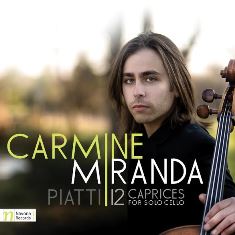
Carmine Miranda. Piatti: 12 Caprices for Solo Cello. Navona Records.
With this, his second solo CD, Venezuelan-American cellist Carmine Miranda makes an important contribution to the cello’s recorded repertoire.
Carlo Alfredo Piatti (1822-1901) was a renowned virtuoso and teacher whose name has faded into obscurity – except to cellists, who know his 12 Caprices from their studies. Miranda, a graduate of the University of Cincinnati College-Conservatory of Music, seeks to return them to the active repertoire, to take their place beside Niccolo Paganini’s Caprices for Solo Violin and Bach’s Suites for Solo Cello and not treated “as mere etudes.” His new release for Navona Records is one of the few on disc (this reviewer found only one other at amazon.com).
“In the same fashion as Paganini,” Miranda writes in his liner notes, “Piatti seeks to expand on the possibilities the cello has to offer . . . . to treat the cello as an extension of the instrumentalist’s body, to the point that one is no longer a musician but a thespian in a one-man play.”
Miranda fulfills Piatti’s goal in these twelve daunting, pieces. Each has a personality of its own and affords the player the opportunity to make an individual musical statement. The opening Allegro quasi presto, a blitz performed at the point of the bow, gives way to the Andante religioso, No. 2, a beauty expressed in agile double-stops. There are dance-like movements such as the quick-as-a-wink No. 3, notated Moderato, and several that recall Bach, such as the bi-partite Allegretto, No. 4, and Nos. 11 and 12.
Piatti explores the full range of the instrument in his set of Caprices, as in the Adagio largamente, No. 6, where Miranda vaults easily from low to high and back, and the Moderato ma energico, No. 8, another dance-like movement that explores the cello’s high register. Miranda’s arresting technique is on full display in the Maestoso (No. 7), where he propels the bow over the strings with great precision and musicality, and in the Allegretto capriccioso, No. 12, which also utilizes fingered harmonics.
Bringing Miranda’s overall objective into full focus is the Adagio – Allegro, No. 11, a daunting melodic movement, where he demonstrates Piatti’s use of “self-accompaniment” with complex double-stopping. (It is to be further noted that this recording was made without editing.)
Thanks to Miranda, it is to be hoped that these impressive and colorful works will return to the concert stage. Release date is Oct. 14.